Join the first international Face2Face Fundraising Congress from 17th-19th November to gain cutting-edge insights and connect with senior level Face2Face experts from all over the world!
 Face2Face Fundraising was born 25 years ago in the streets of Vienna and has since become the biggest monthly donor acquisition tool in the world. Be there when Vienna once more turns into the epicenter of Face2Face Fundraising and join the First International F2F Fundraising Congress !
Face2Face Fundraising was born 25 years ago in the streets of Vienna and has since become the biggest monthly donor acquisition tool in the world. Be there when Vienna once more turns into the epicenter of Face2Face Fundraising and join the First International F2F Fundraising Congress !
Hosted by the Fundraising Association Austria, this unique gathering will connect decision makers and thought leaders from NGOs, fundraising associations and regulators as well as fundraising agencies and service providers from all around the world.
Developed together with a renowned Program Committee, the program will feature outcome-driven sessions exploring crucial developments and sharing best practice around topics like ethical standards and self-regulation, innovation and technology, donor journey, recruitment and team motivation, business models and many more.
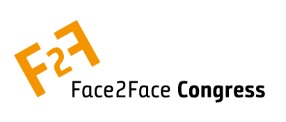 First confirmed speakers include:
First confirmed speakers include:
Dr. Adrian Sargeant, CEO at The Philanthropy Centre (UK)Martin Gaffney, CEO at JAG GROUP (Malaysia)Daryl Upsall, CEO at Daryl Upsall & Associates SL and Daryl Upsall Consulting International SL (Spain)Reinhard Schlossnagel, CEO and Founder at Formunauts (Austria)Dominic Will, Director of Partnerships at Personal Fundraising Services (UK), Eszter Hartay, Senior Legal Advisor at ECNL – European Center for Not-for-Profit Law Stitching (Netherlands)
The first International Face2Face Fundraising Congress enjoys the full support of the European Fundraising Association and numerous leading NGOs, agencies and institutions from all over the world.Registration is going fast with only 100 tickets still available.
Get your ticket now (LINK) to exchange and engage with international delegations from participating organizations such as Médecins sans Frontières (MSF), SOS Children’s Villages, WWF International, DialogDirect, Formunauts and many more.
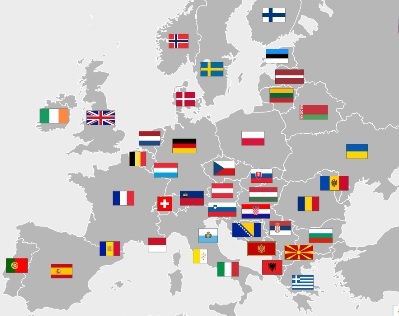 Links to articles & reports
Links to articles & reports January 2020
December 2019
November 2019
 Various sources confirm that the British fundraising sector is recovering slowly, after several years of crisis.
Various sources confirm that the British fundraising sector is recovering slowly, after several years of crisis.
43% of top 100 fundraising charities saw income decrease in 2017/18
Almost half – 43% – of the top 100 fundraising charities in the UK experienced a drop in income during 2017/18, according to the latest Top 100 Fundraisers Spotlight.
The Charity Financials report, published by The Fundraiser, reveals that overall, voluntary fundraised income to the top 100 charities accounted for one-third of all voluntary donations at £5.9bn., increasing by 0.5% after adjusting for inflation.
This is followed by £1.24bn from charitable activities and £0.96bn from statutory income.
The top 10 fundraisers collectively raised £2,186.7m.
Legacy gifts providing 25.8% of voluntary fundraised income, with 2017/18 seeing a growth from £7m to £21m.
Source: UK Fundraising (7 June 2019)
GDPR had major impact on regular giving in 2018, but signs positive for 2019, report shows
Rapidata has released its Charity Direct Debit Tracking Report 2019, which reveals that while GDPR had a major impact on regular giving in 2018, initial signs for 2019 show positive growth.
The report includes new data from January 2017 to end of March 2019 from over 600 charities.
It shows that donor acquisition fell during the months before and after the new regulation came into force in May 2018, while Direct Debit cancellations hit an all-time low.
In 2018 the average annual rate for charity Direct Debit cancellations fell to a record low of 2.14%, while each month of the year apart from January exhibited the lowest rates ever recorded for that month across 15 years of tracking data.
However, donor acquisition volumes for regular giving also fell across 2018: by nearly a third (32%).
This is attributed to significantly less fundraising activity across traditional methods such as direct mail, telephone and face-to-face, while charities focused their resources inhouse on meeting requirements for GDPR compliance.
Source: UK Fundraising (1 July 2019)
Donations declared in tax returns rise to £3.18 billion'
Individuals completing their tax returns for 2017-18 declared charity donations of £3.18 billion, according to HMRC.
12% of people declared a donation: 1,226,000 individuals.
This is a slight increase on the amount declared in the previous tax year but a decrease in the number giving with 2016-17 seeing £3.03bn of donations declared by 1,245,000 individuals.'
Source: UK Fundraising (9 July 2019)
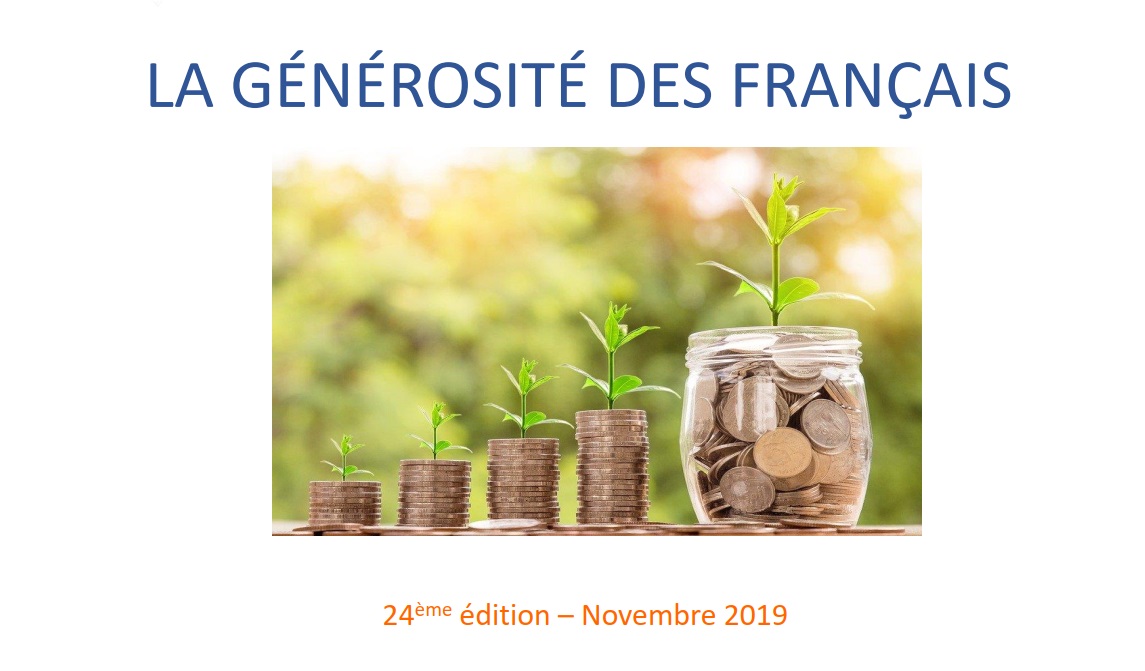 Recherche & Solidarités
Recherche & Solidarités
Le réseau associatif Recherches & Solidarités réunit des experts et des universitaires dont les recherches sont mises au service des acteurs de la solidarité.
Il produit et diffuse régulièrement des enquêtes nationales à l'attention des responsables associatifs et des bénévoles.
Base statistique
Mise en oeuvre sous la responsabilité de Cécile BAZIN, Marie DUROS et Jacques MALET, la 24ème édition annuelle du Rapport sur la Générosité des Français s’appuie sur trois sources:
- données officielles relatives aux donateurs assujettis à l’impôt sur la fortune immobilière (IFI) en 2018, ou sur l’ISF en 2017),
- informations transmises par la Direction générale des Finances publiques (Déclarations de Revenus),
- montants collectés par les plus grandes associations et fondations, publiés au Journal officiel.
Collecte constatée: moins 2%, une bonne surprise !
Le résultat pour 2018 est considéré par les chercheurs comme une bonne surprise, tant les conditions étaient défavorables en France durant cette année: craintes au regard du prélèvement à la source, violents troubles sociaux, mesures imposées aux collecteurs par le RGPD…
Or si on constate une nouvelle baisse du nombre de donateurs (- 4%), celle-ci est compensée par un don moyen en nouvelle hausse de 2%, avec le franchissement symbolique du seuil de 500 euros annuels.
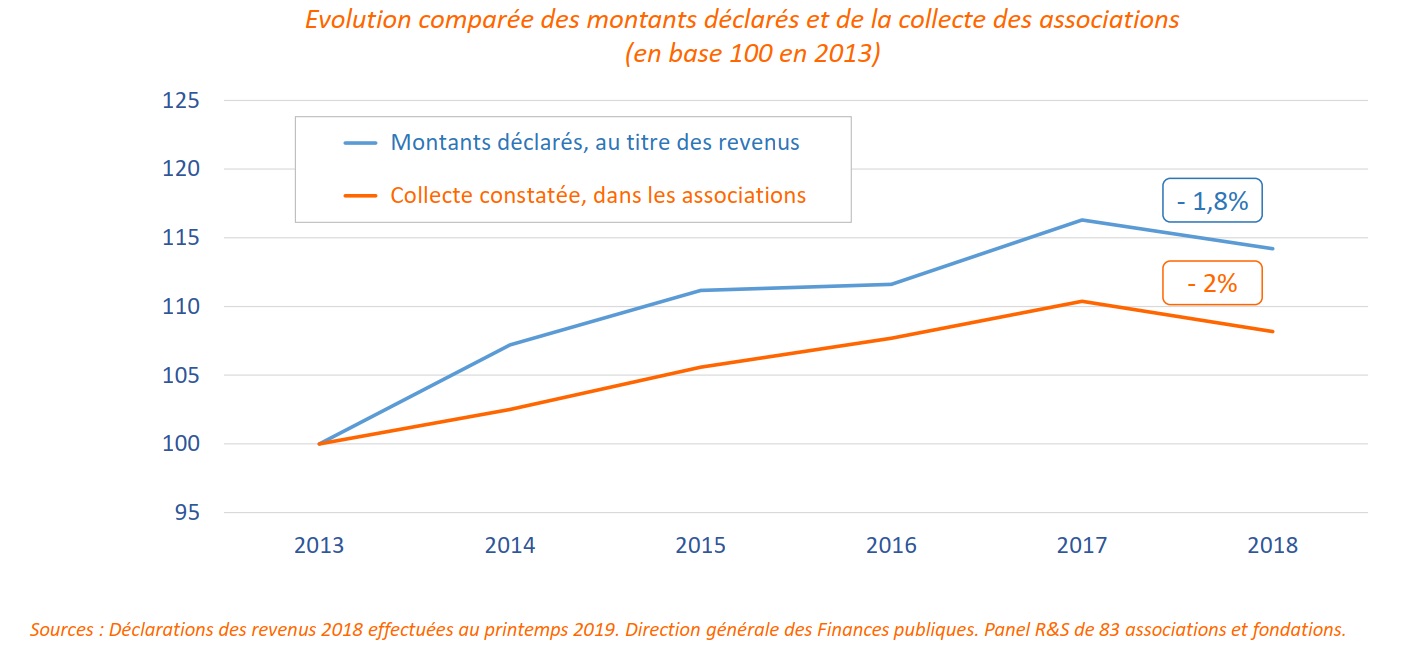
Les jeunes de moins de 30 ans affichent toujours « un effort de don », au regard de leurs revenus (2,3%), tout proche de celui des plus de 70 ans (2,4%).
Réforme de l'ISF: baisse notable des dons
Depuis le 1er janvier 2018, l'Impôt de Solidarité sur la Fortune (ISF) est supprimé et remplacé par un Impôt sur la Fortune Immobilière (IFI). L’assiette, plus étroite, elle est réduite aux biens immobiliers de tous types (appartements, actions de sociétés foncières, etc.).
La baisse des dons, attendue de la part des organismes bénéficiaires, est notable. Les montants sont forte baisse de plus de la moitié, mais avec une belle générosité de la part des donateurs. Ceux-ci ne représentent après la suppression partielle de l'ISF que 15% des assujettis en 2018, mais affichent un don moyen en hausse de 8%, à 5 630 euros.
Estimation de la collecte 2018: entre 4,5 et 4,6 milliards d’euros
Les auteurs de l'étude proposent une estimation globale (hors legs) de la collecte 2018 qui prend en compte trois composantes :
- montant des dons déclarés dans le cadre de l’impôt sur le revenu: 2,55 milliards d’euros.
- estimation des dons qui pourraient faire l’objet d’une déclaration, dans la mesure où ils sont effectués par chèques, virements ou autres procédures permettant de délivrer un reçu fiscal: 1,1 milliard d’euros en 2018.
- estimation des petites sommes (dons de la main à la main, arrondis sur salaire ou arrondis en caisse, dons par SMS…) qui ne peuvent pas faire l’objet d’une déclaration: entre 900 millions et un milliard d’euros.
On parvient à un montant total, hors legs, situé entre 4,5 et 4,6 milliards d’euros pour l’année 2018, fourchette proche de celle qui fut proposée au titre de 2017.
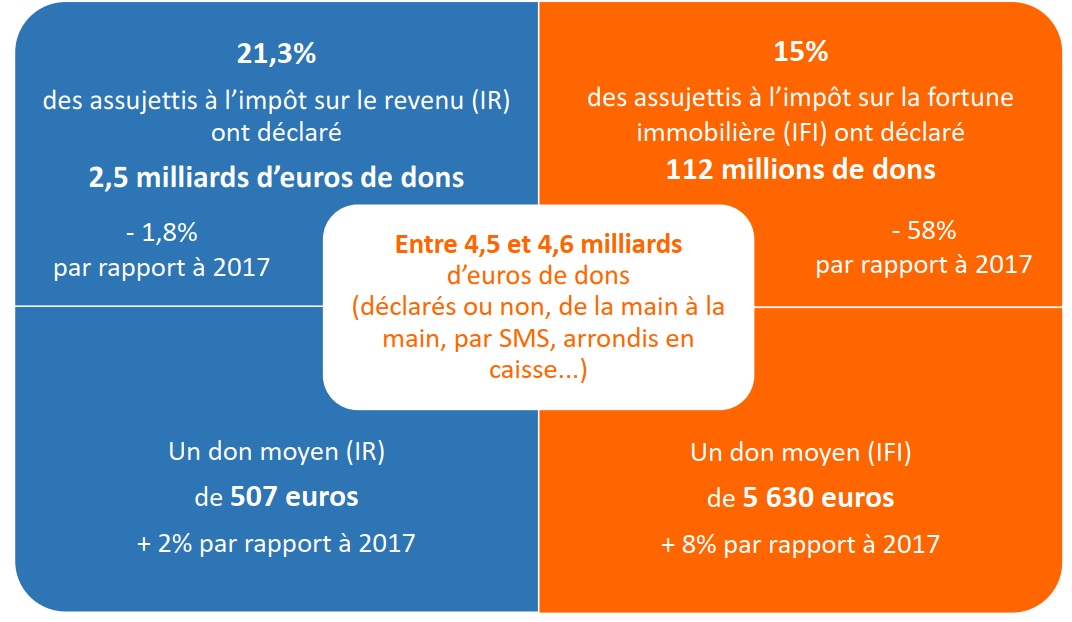
Fondations: - 10%
L’observation du panel constitué par 25 importantes fondations (260 millions d’euros de collecte) nous conduit à un repli de l’ordre de 10% en 2018.
Résultats des 58 collecteurs associatifs les plus importants: baisse de 2%
Le bilan constitué par les 58 collecteurs associatifs les plus importants (pour une assiette un peu supérieure à un milliard d’euros) fait état d'une baisse de l’ordre de 2%.
L'année 2017 s'était au contraire clôturée sur une hausse de 3%.
Cette estimation s’appuie sur les montants de collecte de 2018, auprès des particuliers, hors legs et dons des entreprises.
Ensemble, ces soixante organisations représentent 1,26 milliard d’euros, soit moins de 30% de l’ensemble de la collecte.
Les six premières se détachent nettement, dépassant chacune 53 millions d’euros en 2018.

Source
Recherche & Solidarités - 'La générosité des Français - Rapport 2019'
Goede Doelen Nederland is de brancheorganisatie van ruim 180 erkende goede doelen.
Deze centrale speler in de filantropische sector is het aanspreekpunt namens, voor én over goede doelen in Nederland.
Uit de laatste editie van hun jaarlijks onderzoek bij hun leden blijkt dat de inkomsten van particulieren in 2018 met 1% is gestegen.
Deze lichte groei is eerder te danken aan de positieve resultaten van de kleine en middelgrote verenigingen (+10%) dan die van de grote structuren (-1,4%).
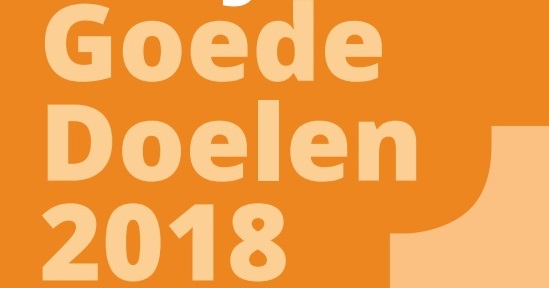 Om zicht te krijgen op de ontwikkelingen is gebruik gemaakt van de gegevens van het Centraal Bureau Fondsenwerving (CBF). Dit jaar hebben 158 van de 178 leden deelgenomen aan het onderzoek.
Om zicht te krijgen op de ontwikkelingen is gebruik gemaakt van de gegevens van het Centraal Bureau Fondsenwerving (CBF). Dit jaar hebben 158 van de 178 leden deelgenomen aan het onderzoek.
De totale inkomsten van goede doelen zijn in 2018 licht gestegen (2%), net als het bedrag wat gereserveerd is voor doelbesteding.
Inkomsten afkomstig van particulieren
De inkomsten afkomstig van particulieren zijn onderverdeeld in inkomsten uit collecten, nalatenschappen, contributies en giften & donaties.
In totaal zijn deze inkomsten gestegen met 1%, ofwel met een bedrag van 12 miljoen euro.
De inkomsten uit nalatenschappen zijn na giften & donaties de belangrijkste inkomsten afkomstig van particulieren en zijn in 2018 gestegen met 5%.
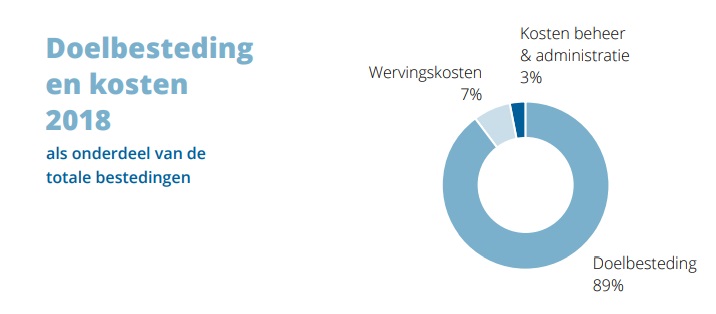 Bestedingen
Bestedingen
Goede doelen hebben 3 soorten bestedingen: bestedingen aan het maatschappelijke doel (doelbesteding), aan werving en aan de organisatie (beheer en administratie).
In 2018 hebben de aan het onderzoek deelnemende goede doelen € 2,8 miljard besteed aan hun doelstelling, dat is bijna € 27 miljoen meer dan in 2017 (+1%).
Leden en donateurs
Er is sprake van een lichte daling van 1% in het aantal leden en donateurs (10 miljn. i.p.v. 10,1 mlj.).
Deze daling trad alleen op bij de grote organisaties.
Bij middelgrote en kleine organisaties was een lichte stijging van 1% te zien.
Bij organisaties in de categorie Kunst & cultuur was sprake van de grootste stijging met 15%.
De meeste donateurs vindt men in de sector 'Internationale hulp & mensenrechten' (39%), gevolgd door Gezondheid (22%), 'Natuur & Milieu' (20%) en Welzijn (13%).
Totale inkomsten
De totale inkomsten van de deelnemende goede doelen bedroegen in 2018 3,1 miljard euro.
Dat is 2% meer dan in 2017.
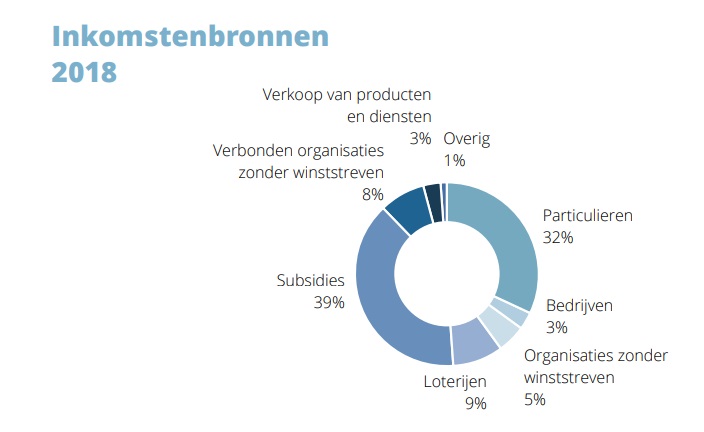 Inkomsten van particulieren
Inkomsten van particulieren
Goede doelen verkregen 32% van hun inkomsten van particulieren, 9% van bedrijven en 39% uit subsidies.
Bij kleine organisaties zijn de inkomsten met 11% het meest gestegen.
Dit komt vooral door een stijging van inkomsten van particulieren, met name de inkomsten uit nalatenschappen en giften & donaties.
Bij kleine organisaties komt meer dan de helft van de inkomsten van particulieren.
 Giften & donaties, legaten
Giften & donaties, legaten
De onderverdeling van de inkomsten naar wervingskanaal geeft een duidelijk zicht over de omvang van giften & donaties, collecten, nalatenschappen en contributies.
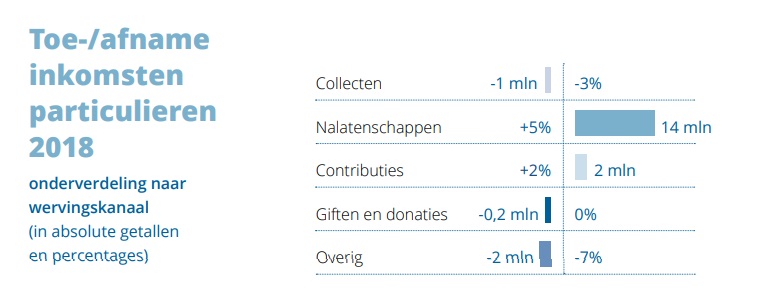
De inkomsten uit nalatenschappen zijn na giften & donaties de belangrijkste inkomsten verkregen van particulieren.
Zij maken een kwart van de totale inkomsten particulieren uit.
Uit het laatste tabel van dit artikel blijkt dat de lichte groei van 1% uit inkomsten 'Particulieren' grotendeels te danken is aan de positieve evolutie van de inkomsten uit nalatenschappen.
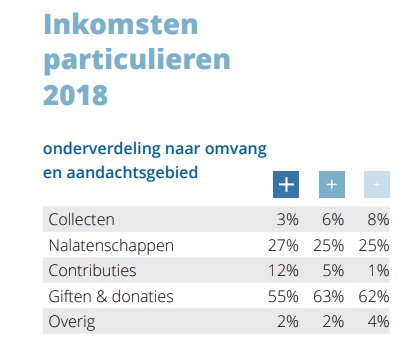 Diverse resultaten worden volgens de omvang van de totale inkomsten uitgesplitst:
Diverse resultaten worden volgens de omvang van de totale inkomsten uitgesplitst:
. Groot: > 20 mln € totale inkomsten
. Middel: 5-20 mln € totale inkomsten
. Klein: < 5 mln € totale inkomsten
Het tabel 'Onderverdeling naar omvang van de verenigingen' toont gelijkaardige percentages m.b.t. de diverse de inkomstenbronnen bij particulieren: collectes, nalatenschappen, giften en donaties, enz.
Inkomsten onderverdeeld naar inkomstenbron / naar omvang
Giften & donaties zijn verreweg de belangrijkste inkomstenbron voor alle soorten organisaties ongeacht hun omvang.
Kleine verenigingen hangen meer af van de vrijgevigheid van particulieren en bedrijven grote instellingen:
- Groot (> 20 mln. € totale inkomsten) kregen 806 mln. € uit particulieren en bedrijven, 1,1 miljard € uit subsidies.
- Klein: (< 5 mln. € totale inkomsten) kregen 65 mln. € uit particulieren en bedrijven, 7 mln. € uit subsidies.
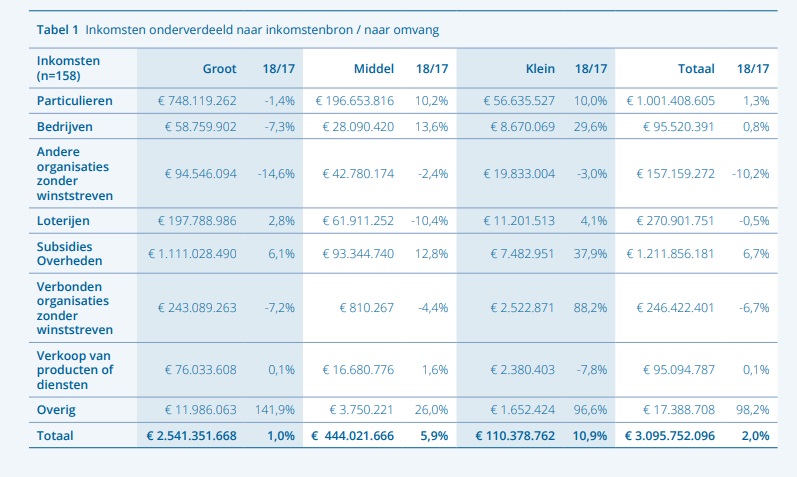
Inkomsten Particulieren onderverdeeld naar wervingskanaal / naar omvang
In 2018 was de lichte groei van de inkomsten uit particulieren eerder te danken aan de positieve resultaten van de kleine en middelgrote verenigingen (+10%) dan die van de grote structuren (-1,4%).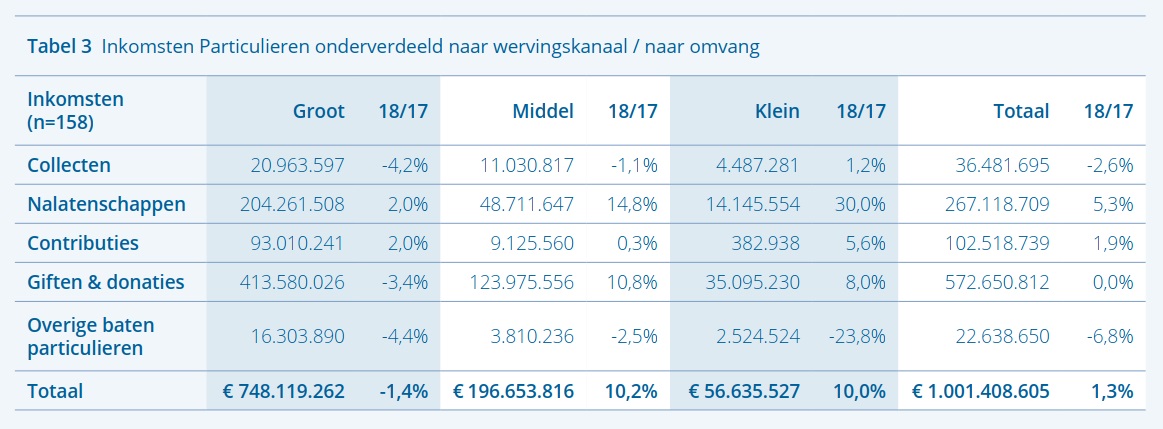
Bron
Goede Doelen Nederland - 'Onderzoek Goede Doelen Nederland 2018 - Feiten en Cijfers'